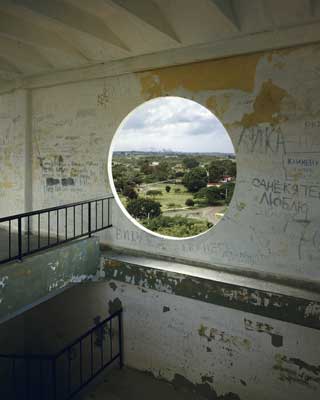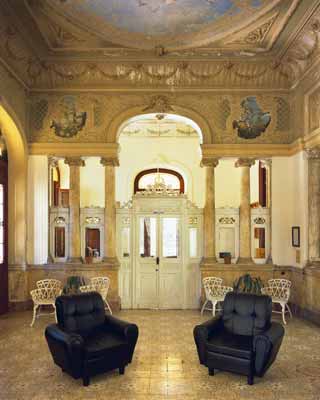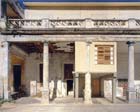
Beach Resort / Cultural Centre, Tarara, 2004.
C-Print mounted on aluminum,
40" x 32"

Quarry, Vedado, 2004.
C-Print mounted on aluminum,
48" x 73"

Quinta Rosario /
"Fructuoso Rodríguez Secondary School, Vedado, 2004.
C-Print mounted on aluminum,
57" x 48"

Barbacoa, Vedado, 2004.
C-Print mounted on aluminum,
48" x 54 3/4"
In some of the photographs it's hard to know where you are, what the surrounding space represents. Beach Resort / Cultural Centre, Tarara has a plain wall slanting to the left, with a large, circular cutout through which one sees the landscape beyond. The space drops down in front of us with a staircase descending into the darkness in the lower left. The floor at our level appears at the left with a rail in front of it guarding against the drop into the space. The composition is a perfect arrangement of major diagonals, a few verticals, the horizontal of the landscape, and the circle of the cutout (which we know is not a perfect circle but accept as one), like a Constructivist page design that carries in each of its insistent directions the oddities of typography and other human evidence. These photographs are different, though. They allow the art of others to be recorded, to intervene and become part of the photographer's art--structures designed or improvised by people; roads and lawns and clumps of trees; the phrases and names of people who have passed through, in this case the Ukrainian (or Russian) graffiti of children afflicted with radiation poisoning from the disaster at Chernobyl who were living and being treated here for a while. That is the prism, both theirs and Douglas's (and therefore ours), through which the circular landscape, the earth, is seen. The landscape stretches out, through the green and the tiny figures on the path at the left, toward the distant horizon where the smoke of the industrial, or simply the modern world, rises into the gray clouds, all this before the facility, apparently, is to be renovated to accommodate visiting foreign businessmen, when, presumably, another context will be created and this aesthetic will no longer exist, except in this picture.
There are layers upon layers, as in an archaeological dig, and, in fact one of the photographs, Quarry, Vedado, is almost precisely that. The earth in the foreground is excavated, as though for some kind of reconstruction or need to go beneath the surface. But of course it is a quarry, a mine, the one in which the Cuban revolutionary hero José Martí worked when he was a political prisoner at the age of sixteen in the late 19th century. The apartments and streets grew up around that space, partly as though it were not there but also in recognition of its significance. The buildings seem suspended around the quarry; it is part of their existence, and certainly of their form. Like one of the rings of hell, it underlies the full range of human activities and structures. Following the trees from right to left, one is led to a barely perceptible opening onto an elevated street and sidewalk where people stroll, a street that begins with the quarry but always with the suggestion that the quarry is beneath it, through the door in the rock wall that supports it.
Most of Douglas's pictorial spaces are like vestibules, places into which we have been ushered to await the unfolding of events. They are very evidently encapsulations of time, from before the Revolution, or before before the Revolution, until now (or then, when the pictures were taken). While we are waiting, there are more details to see than in any other works of art I can think of--a dog lying asleep on a roof, clothes on a line out the window drying in the sun, the reflection of a man hunched over a desk, leaves fallen on the ground, surface textures of infinite variety--all related to one another and all absolutely of the moment they were seen together. In Malecón, depicting the promenade around Vedado and Havana, the sea crashes against the retaining wall and the great plume of water seems to dance with the angled cannon and the tall, stooped street lights. We may be waiting, but we really are there, in all the complexity of thereness.